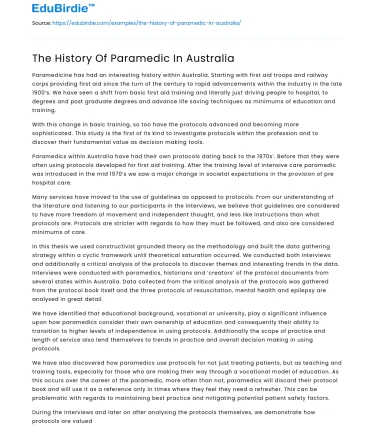Paramedicine has had an interesting history within Australia. Starting with first aid troops and railway corps providing first aid since the turn of the century to rapid advancements within the industry in the late 1900’s. We have seen a shift from basic first aid training and literally just driving people to hospital, to degrees and post graduate degrees and advance life saving techniques as minimums of education and training.
With this change in basic training, so too have the protocols advanced and becoming more sophisticated. This study is the first of its kind to investigate protocols within the profession and to discover their fundamental value as decision making tools.
Paramedics within Australia have had their own protocols dating back to the 1970s’. Before that they were often using protocols developed for first aid training. After the training level of intensive care paramedic was introduced in the mid 1970’s we saw a major change in societal expectations in the provision of pre hospital care.
Many services have moved to the use of guidelines as opposed to protocols. From our understanding of the literature and listening to our participants in the interviews, we believe that guidelines are considered to have more freedom of movement and independent thought, and less like instructions than what protocols are. Protocols are stricter with regards to how they must be followed, and also are considered minimums of care.
In this thesis we used constructivist grounded theory as the methodology and built the data gathering strategy within a cyclic framework until theoretical saturation occurred. We conducted both interviews and additionally a critical analysis of the protocols to discover themes and interesting trends in the data. Interviews were conducted with paramedics, historians and ‘creators’ of the protocol documents from several states within Australia. Data collected from the critical analysis of the protocols was gathered from the protocol book itself and the three protocols of resuscitation, mental health and epilepsy are analysed in great detail.
We have identified that educational background, vocational or university, play a significant influence upon how paramedics consider their own ownership of education and consequently their ability to transition to higher levels of independence in using protocols. Additionally the scope of practice and length of service also lend themselves to trends in practice and overall decision making in using protocols.
We have also discovered how paramedics use protocols for not just treating patients, but as teaching and training tools, especially for those who are making their way through a vocational model of education. As this occurs over the career of the paramedic, more often than not, paramedics will discard their protocol book and will use it as a reference only in times where they feel they need a refresher. This can be problematic with regards to maintaining best practice and mitigating potential patient safety factors.
During the interviews and later on after analysing the protocols themselves, we demonstrate how protocols are valued by the organisation as tools to monitor paramedic performance and to meet organisational and governmental key performance indicators.
Finally in the recommendations chapter we suggest ways to develop better protocols with relation to realising how barriers and facilitators can play an impact upon decision making. Fundamental to creating ‘good’ protocols are understanding who the audience is [who they should be aimed at] and again understanding the expectations/requirements of both the paramedic and the organisation. We provide a potential framework in the development of paramedic protocols which can be tailored to the organisation.






 Stuck on your essay?
Stuck on your essay?

